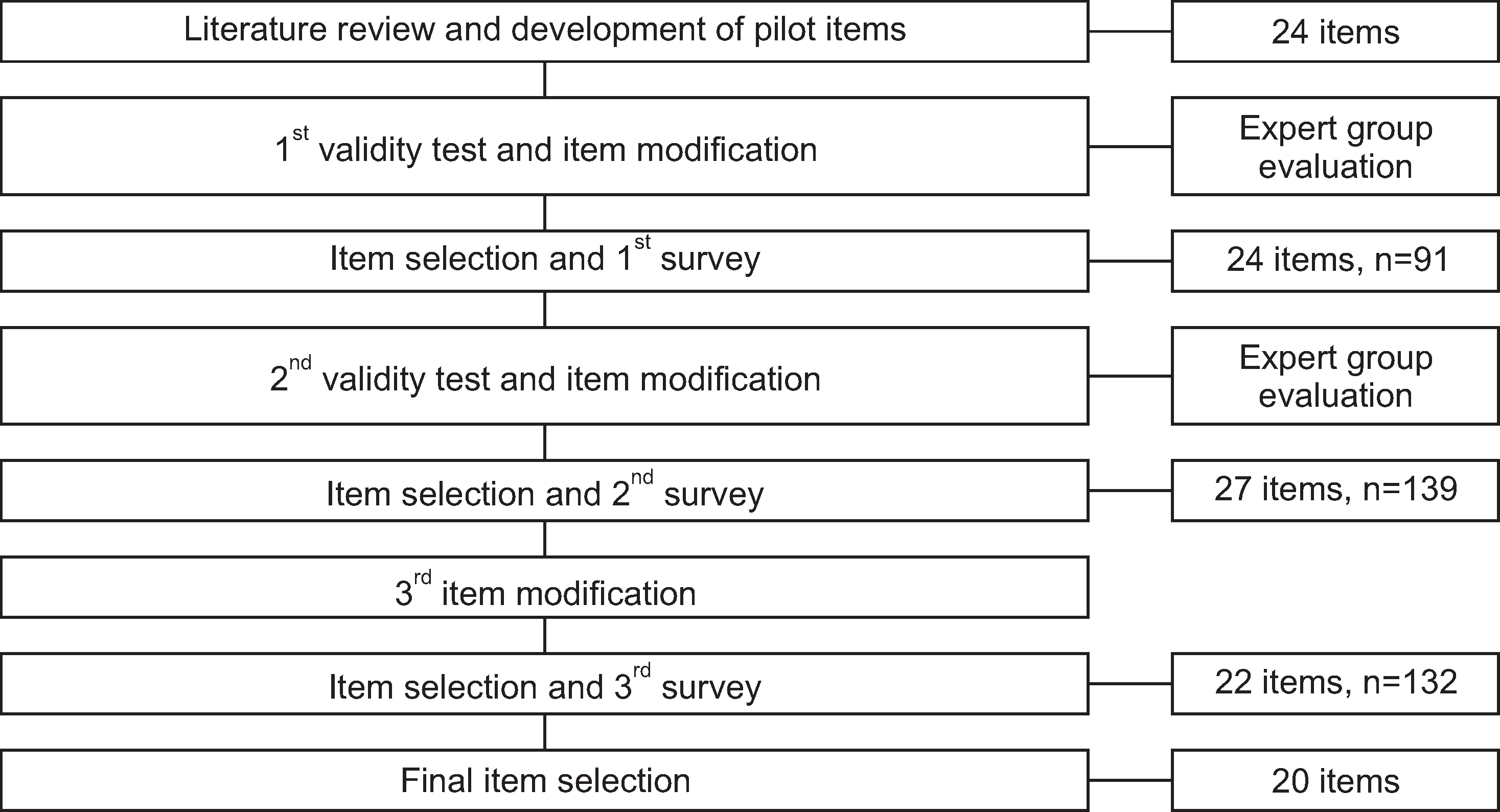J Korean Acad Oral Health.
2017 Sep;41(3):214-221. 10.11149/jkaoh.2017.41.3.214.
Development of oral health literacy assessment tool for fifth and sixth grade elementary school students
- Affiliations
-
- 1Department of Preventive & Community Dentistry, Chonbuk National University Dental School, Jeonju, Korea. prevdent@chonbuk.ac.kr
- 2Institute of Oral-bio Science, Chonbuk National University Dental School, Jeonju, Korea.
- KMID: 2392441
- DOI: http://doi.org/10.11149/jkaoh.2017.41.3.214
Abstract
OBJECTIVES
The purpose of this study was to develop and appraise an oral health literacy assessment tool for upper elementary school students.
METHODS
Twenty-eight preliminary assessment items were developed on the basis of various types of oral health education literature for children. They contained verbal and functional sections and they were classified into 2 cognitive processes (literal and inferential). The questionnaires were analyzed using the testAn v.1.0 program for identified Cronbach's α, item discrimination, and difficulty through classical test theory. A final evaluation tool was developed and selected by conducting three surveys and 20 items.
RESULTS
The final survey was completed by 132 fifth and sixth grade elementary school students in Seoul. The Cronbach's α value, item discrimination, and difficulty were .71, .38, and .75, respectively. The mean score for oral health literacy of children was 14.9 (±3.2, theoretical range: 0-20, 75% correct answers).
CONCLUSIONS
These results suggest that this tool could be relied on to help determine the level of oral health literacy in children and in preparing appropriate oral health education programs for children.
Keyword
Figure
Cited by 1 articles
-
Oral health literacy of upper grade elementary school children
Jinsil Hong, Young-Sam Kim, Kee-Wan Chang
J Korean Acad Oral Health. 2018;42(4):229-237. doi: 10.11149/jkaoh.2018.42.4.229.
Reference
-
References
1. National Center for Health Statistics. Healthy people 2010: Final review. Washington: Government Printing Office;2011. p. 21–3.2. Berg JH, Slayton RL. Early childhood oral health. New Jersey: John Wiley & Sons;2015. p. 200–201.3. Jones M, Lee JY, Rozier RG. Oral health literacy among adult patients seeking dental care. J Am Dent Assoc. 2007; 138:1199–1208.
Article4. Lee JY, Rozier RG, Lee SYD, Bender D, Ruiz RE. Development of a word recognition instrument to test health literacy in dentistry: the REALD-30-A brief communication. J Pub Health Dent. 2007; 67:94–98.5. Ratzan S, Parker R. National library of medicine current bibliographies in medicine: Health literacy. Bethesda, M: National Institutes of Health, US Department of Health and Human Services;2000. p. 5.6. Manganello JA. Health literacy and adolescents: a framework and agenda for future research. Health Educ Res. 2008; 23:840–847.
Article7. Roberts C, Freeman J, Samdal O, Schnohr CW, de Looze ME, Nic Gabhainn S, et al. The health behaviour in school-aged children(HBSC) study: methodological developments and current tensions. Int J Public Health. 2009; 54:140–150.8. Cho EP, Kim GH, Jang GH, Cha Jl. Evaluation of health center school oral health programs. Seoul: Korea Health Promotion Foun-dation;2012. p. 3–5.9. Ju HJ, Oh HW, Kim JY, Lee HS. A cross-sectional study on oral health literacy and its influencing factors among adults: I. Verbal oral health literacy. J Korean Acad Oral Health. 2012; 36:97–105.10. Ju HJ, Oh HW, Lee HS. A cross-sectional study on oral health literacy and its influencing factors among adults: II. Functional oral health literacy. J Korean Acad Oral Health. 2013; 37:81–88.
Article11. Lee HJ, Hong JS, Kim JY, Chang KW. Pilot study on development of oral health literacy evaluation tool for Korean adults. J Korean Acad Oral Health. 2015; 39:237–244.
Article12. Namkoong EJ, Park DY, Jung SH, Ma DS. Oral health literacy of mothers belonging to multi-cultural families in Gangneung City: a case study. J Korean Acad Oral Health. 2016; 40:71–78.
Article13. Park SK. Development of the Korean Health Literacy Instrument for the Late School-aged Children [dissertation]. Jeonju: Chonbuk National University;2014. [Korean].14. Gong DA, Lee JY, Rozier RG, Pahel BT, Richman JA, Vann WF JR. Development and testing of the test of functional health literacy in dentistry(TOFHLiD). J Public Health Dent. 2007; 67:105–112.15. Lee JS. Modern educational evaluation. Gyeong Gi: Kyoyookbook;2009. 160:p. 193–199.16. Lynn MR. Determination and quantification of content validity. Nursing research. 1986; 35:382–386.
Article17. Santos JRA. Cronbach’s alpha: A tool for assessing the reliability of scales. J Ext. 1999; 37:1–5.18. Kelley TL. The selection of upper and lower groups for the validation of test items. J Educ Psychol. 1939; 30:17.
Article19. Sung TJ, Kim KH. An investigation of changes of the reliability coefficients and the test information functions by varying the number of items, item discrimination, and item difficulty. Journal of Educational Measurement. 1993; 6:123–154.20. Miller E, Lee JY, DeWalt DA, Vann WF. Impact of caregiver literacy on children’s oral health outcomes. Pediatrics. 2010; 126:107–114.
Article21. Bridges SM, Parthasarathy DS, Wong HM, Yiu CK, Au TK, McGrath CP. The relationship between caregiver functional oral health literacy and child oral health status. Patient Educ Couns. 2014; 94:411–416.
Article22. Khodadadi E, Niknahad A, Sistani MMN, Motallebnejad M. Parents’ oral health literacy and its impact on their children’s dental health status. Electronic Physician. 2016; 8:3421–3425.
Article23. Jang BS, Kim DH. Health Literacy and Health Behavior in Late School-age Children. J Korean Acad Community Health Nurs. 2015; 26:199–208.
Article24. Seong TJ. Modern educational evaluation. Seoul: Hakjisa;2010. Chapter14.25. Ahn EJ, Kwon IS. Health literacy of elementary school students. Child Health Nurs Res. 2014; 20:322–331.
Article26. Kim SW, Seo H, Yoon JC, Lee KK, Jung GJ, Lim SI. The foundation of the National Literacy Survey. Seoul: The national institute of the Korean language;2008. p. 17.
- Full Text Links
- Actions
-
Cited
- CITED
-
- Close
- Share
- Similar articles
-
- Health Literacy of Elementary School Students
- Oral health literacy of upper grade elementary school children
- The Effects of Sex Education on the Knowledge and Attitude toward Sex in Sixth Grade Elementary School Students
- Oral health literacy and related socioeconomic factors in mothers
- The impact of high school students’ health literacy on health promotion behaviors: Focusing on the mediating effect of health empowerment


